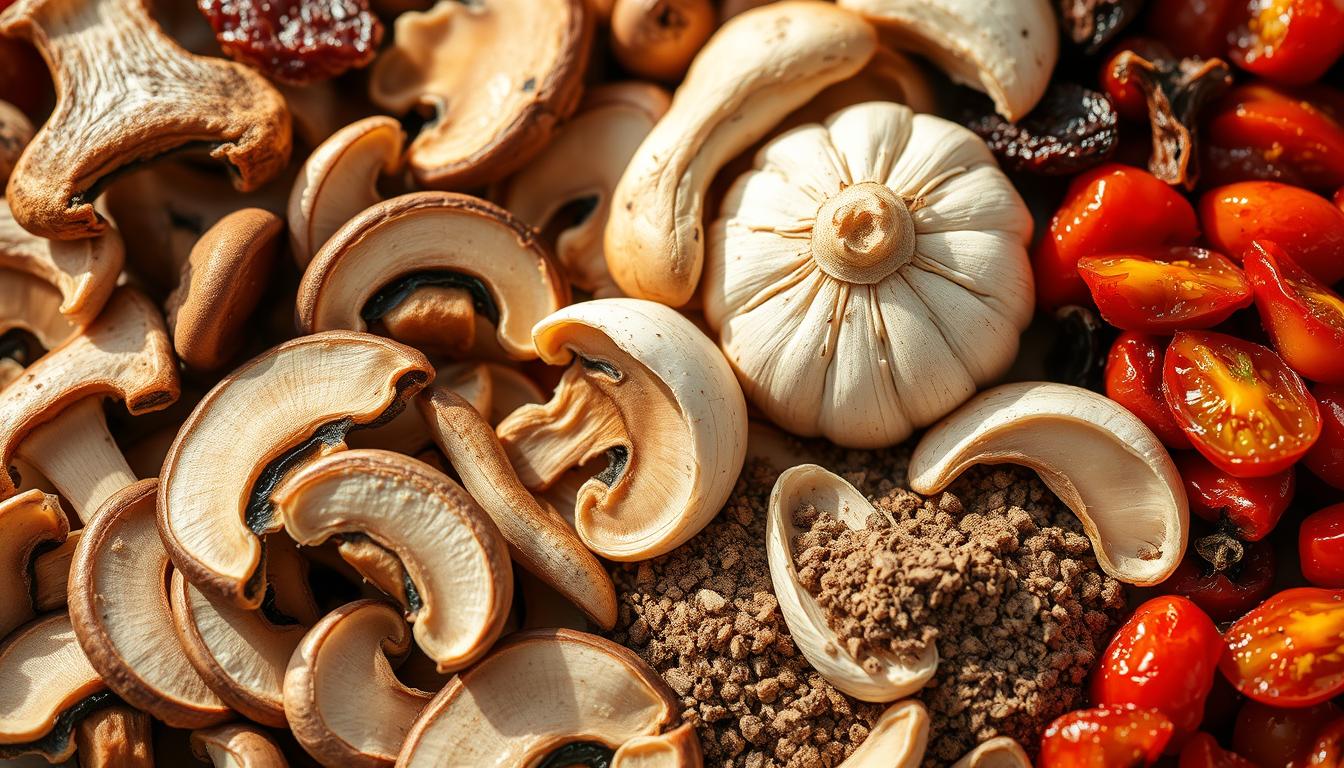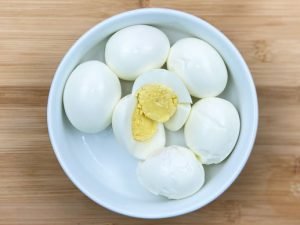That satisfying taste in your favorite soups? It’s not magic—it’s umami. This fifth taste makes broths irresistible. Chefs like David Chang’s Momofuku team have found ways to boost this flavor, and their methods are easy for anyone to try.
Don’t just use salt and spices. Ingredients like fermented miso, aged cheeses, and sun-dried mushrooms are flavor boosters. They add glutamates and nucleotides for a richer taste. Even simple additions can make a big difference without overpowering other flavors.
Key Takeaways
- Umami activates savory receptors for deeper flavor profiles
- Momofuku’s research identifies five proven enhancers
- Fermented items like miso provide concentrated depth
- Dried mushrooms release nucleotides during cooking
- Tomato paste adds acidity to balance richness
- Seaweed offers iodine for mineral complexity
Whether you’re making chicken noodle or ramen, these upgrades are easy. We’ll show you how to use Parmesan rinds and kombu for the best results. You’ll make every spoonful taste like it simmered for hours, even if you’re in a hurry.
Understanding Umami in Soup Bases
Your favorite soups have a secret ingredient that makes them irresistible. Umami, often called the “fifth taste,” adds a depth of flavor that keeps you coming back. Unlike other tastes, umami builds up slowly, leaving you wanting more.

What Makes Umami Unique
Umami’s magic comes from glutamate molecules that send signals to your tongue. Wired Magazine says “umami compounds act like flavor amplifiers, making your brain perceive other tastes more intensely”. This is why tomato soups taste richer and mushroom broths feel more substantial.
Three key elements make umami special:
- Time-release effect: Savory notes develop slowly compared to immediate sweet or salty hits
- Collaborative nature: Works best when combined with other savory elements like nucleotides
- Physical response: Triggers saliva production, enhancing overall flavor perception
Science Behind Savory Flavor Enhancement
Modern kitchens use food science to boost umami. Momofuku’s R&D team, for example, extracts glutamate to enhance flavors. You can do the same with strategic cooking.
Glutamate Receptors Explained
Your tongue has special receptors for glutamate. When these receptors are activated, your brain gets a savory signal. MSG, often misunderstood, is just concentrated glutamate found in foods like Parmesan and seaweed.
Synergy With Other Taste Elements
Umami works best with others:
- Salt: Enhances glutamate receptor sensitivity by 50%
- Acidity: Prevents flavor fatigue in long-simmered soups
- Sweetness: Balances umami’s intensity in cream-based recipes
This teamwork is why chicken noodle soup gets better with parmesan rind and why miso pairs well with mirin. By combining different savory elements, you get a complex flavor enhancement that simple salt can’t match.
“Soup bases act like flavor sponges – their liquid matrix allows umami compounds to disperse evenly and interact freely with other taste elements.”
Knowing this science helps you make better choices. Should you add fish sauce early or late? Does roasted garlic outperform fresh? The answers depend on how preparation methods affect glutamate and receptor activation. This knowledge can turn good soups into unforgettable ones.
Mushroom Power: Nature’s Umami Bomb
Mushrooms turn simple broths into deep, savory dishes. They add a rich flavor through their glutamates. We’ll look at how to use them best by choosing the right types and how to prepare them.
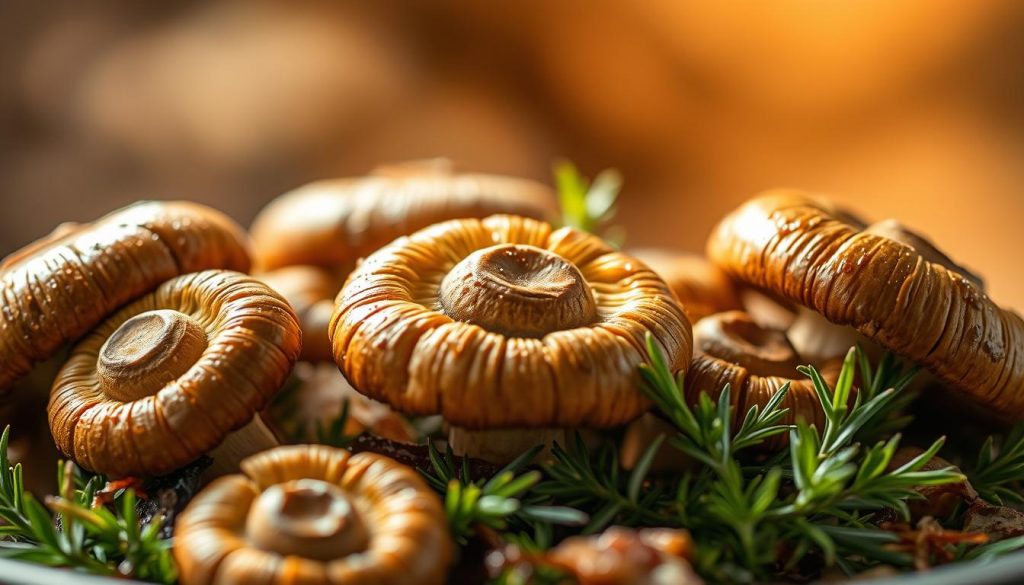
Best Mushroom Varieties for Broth
Not all mushrooms are created equal when it comes to flavor. Some are better at adding depth to your soups. Let’s explore two top picks:
Shiitake vs Porcini Comparison
| Mushroom Type | Flavor Profile | Best Use | Preparation Tip |
|---|---|---|---|
| Shiitake | Smoky, meaty | Asian-inspired soups | Momofuku’s shiitake dust: Pulverize dried caps into a fine powder |
| Porcini | Nutty, robust | European-style broths | Timothy Pakron’s technique: Toast dried slices before grinding |
Shiitake mushrooms add a bold flavor to miso ramen. Porcini mushrooms make French onion soup richer. Keep powdered forms of both on hand for a quick flavor boost.
Dried vs Fresh Mushroom Techniques
Dried mushrooms pack a stronger flavor than fresh ones. But fresh mushrooms add texture and a subtle taste. Here’s how to mix them for the best results:
Rehydration Methods for Maximum Flavor
Tests show the best ways to soak dried mushrooms:
| Method | Time Required | Flavor Yield |
|---|---|---|
| Cold water soak | 4-6 hours | Mild, balanced |
| Hot water soak | 30 minutes | Intense, quick |
| Simmer in broth | 15 minutes | Rich, integrated |
Don’t throw away the soaking liquid. It’s a treasure for soups. Mix dried and fresh mushrooms in a 1:3 ratio for a complex flavor. This method ensures you get every bit of flavor.
“Grinding dried mushrooms into powder lets you sneak umami into broths without altering texture.”
For fresh mushrooms, roast them first. This caramelizes their sugars and boosts their savory taste. They’re perfect for creamy soups.
Fermented Fish Sauce Transformation
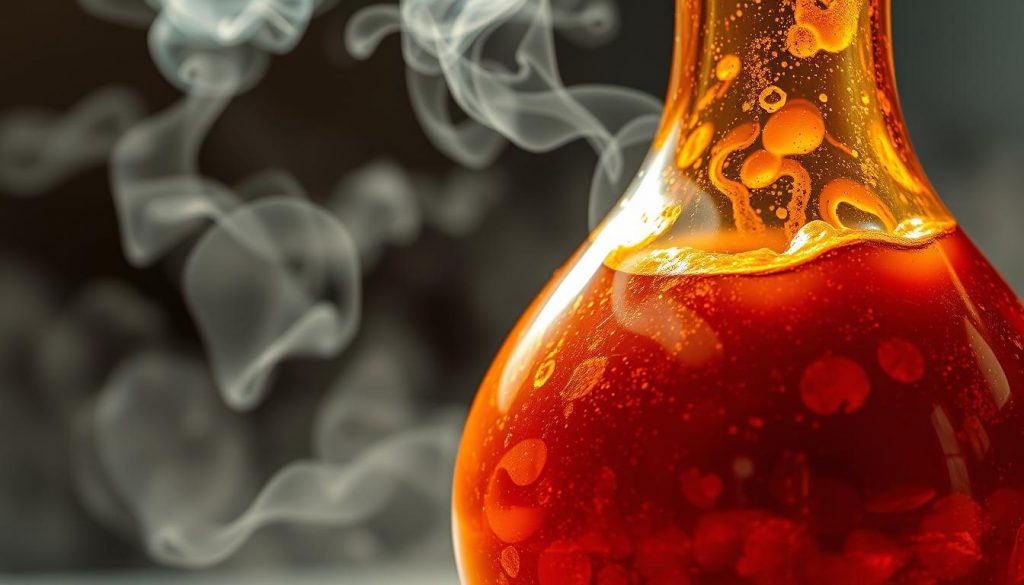
Fish sauce is more than a condiment. It’s a flavor accelerator that turns bland broths into savory masterpieces. It adds a punch of umami that blends well with other ingredients. But, it must be used carefully to avoid overpowering the soup.
Choosing Quality Fish Sauce
Not all fish sauces are the same. High-quality ones use wild-caught anchovies and ferment for up to 24 months. This creates a deeper flavor. Food scientist Raquel Pelzel says:
“The best fish sauces taste like the ocean’s essence—salty, funky, but never fishy.”
Red Boat vs Thai Kitchen Comparison
| Brand | Ingredients | Fermentation Time | Sodium per Tbsp | Best For |
|---|---|---|---|---|
| Red Boat | Anchovies, salt | 12-24 months | 1390mg | Clear broths, delicate soups |
| Thai Kitchen | Anchovies, salt, sugar | 6-8 months | 1560mg | Hearty stews, bold flavors |
For plant-based options, Pelzel suggests using vegan kimchi juice. It’s fermented for 3 weeks and has a similar pH to fish sauce. This acidity helps dissolve flavors in broth without adding seafood taste.
Timing and Quantity Guidelines
Momofuku’s chefs have a golden rule:
“Add fish sauce in three waves—during sautéing, simmering, and finishing—to layer umami without dominance.”
Avoiding Overpowering Other Flavors
- Early Addition: 1 tsp during aromatics cooking boosts base flavors
- Mid-Process: ½ tbsp deglazes pans or enriches simmering broth
- Final Touch: ¼ tsp at serving brightens without salt overload
Test your broth’s balance by waiting 2 minutes after adding fish sauce. This allows flavors to fully mix. If it’s too salty, add a squeeze of lime or a dash of coconut sugar.
Soy Sauce & Miso Magic
Discover the deep flavors of soy sauce and miso paste. They turn simple soups into amazing dishes. Each has its own unique taste, needing special ways to use them. Let’s dive into how to use these ingredients like a pro.
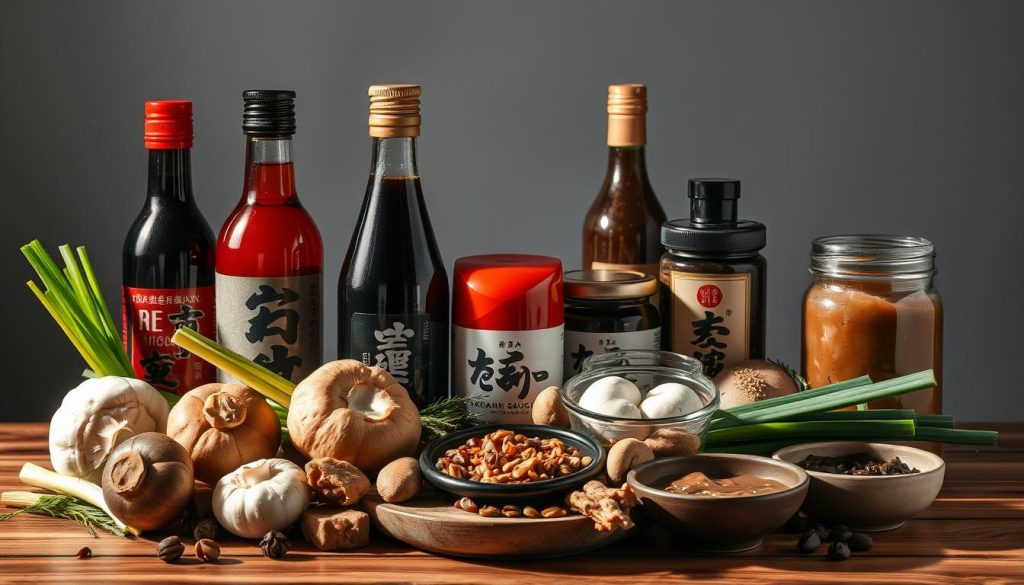
Light vs Dark Soy Sauce Applications
Light soy sauce is great for light broths. It adds saltiness without changing the color. Use it in clear soups or seafood dishes at the end of cooking.
Dark soy sauce adds a rich flavor to thick soups. Its long fermentation makes it perfect for beef noodle soups or mushroom ramen. Add it early to mix with other flavors.
Tamari for Gluten-Free Options
Tamari is gluten-free and has a smooth umami taste. It’s thicker, so whisk it into soups or drizzle on top. It’s great for gluten-free pho or miso ramen, letting spices shine.
Miso Paste Incorporation Methods
Never boil miso. High heat kills its good bacteria and dulls the taste. Mix it with warm broth and then add it to your soup. For vegetable bisques, caramelize red miso with olive oil for a flavor boost.
White vs Red Miso Flavor Profiles
| Type | Fermentation Time | Flavor Notes | Best Uses |
|---|---|---|---|
| White Miso | 2-8 weeks | Sweet, mild, fruity | Light broths, fish soups, dressings |
| Red Miso | 1-3 years | Bold, salty, earthy | Stews, root vegetable soups, marinades |
Use white miso with tofu or snap peas. Red miso is good with roasted garlic or smoked meats. Mixing both in mushroom barley soup adds depth.
“The magic happens when you treat miso like fresh herbs – add it last to preserve its character.”
Learning to use soy sauce and miso takes your cooking to the next level. Keep miso in the fridge and soy sauce airtight to keep their flavors strong.
Tomato Concentrate Boost
Discover the secret to making your soups more savory. Tomatoes, when cooked right, release lycopene. This compound boosts depth of flavor by adding glutamates. Chefs at Momofuku use tomato dashi to add richness, mixing paste with kombu and Parmesan.
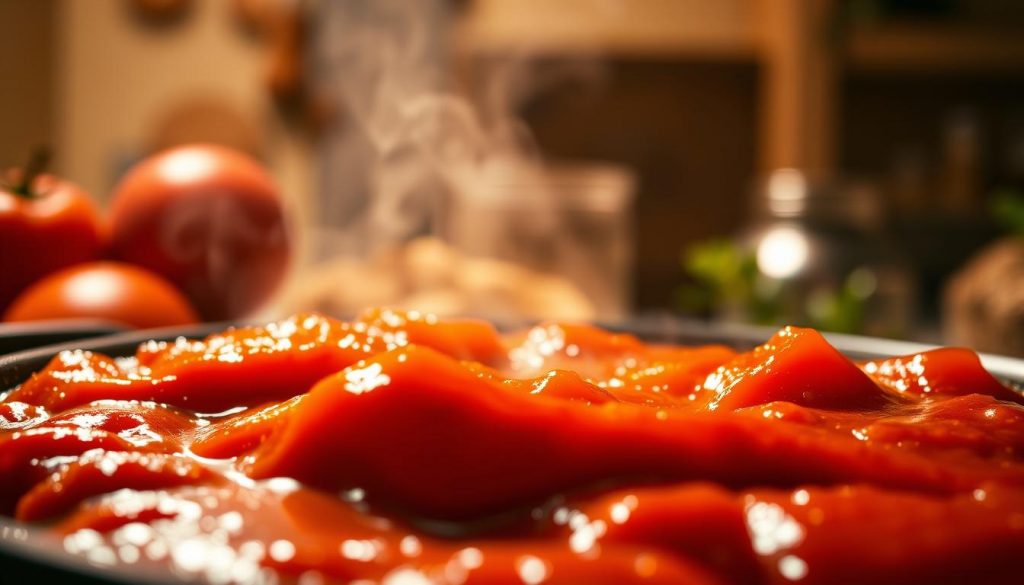
Tomato Paste vs Fresh Tomatoes: Flavor Face-Off
Decide based on how intense you want the flavor:
- Tomato paste has 10x more lycopene than fresh tomatoes
- Fresh tomatoes add a bright acidity to broths
- Use both for a mix of savory elements in meat soups
Mastering Caramelization Techniques
Heat can transform your tomato base:
- Cook paste in oil until it turns brick-red (5-7 minutes)
- Use stock to deglaze and capture flavors
- Add fresh tomatoes last to keep them bright
| Factor | Tomato Paste | Fresh Tomatoes |
|---|---|---|
| Umami Concentration | High (3.5g glutamates/100g) | Medium (0.3g/100g) |
| Best Use | Hearty stews | Clear broths |
Herb and Spice Pairing Principles
Boost tomato flavor with the right herbs and spices:
- Smoked paprika adds a meaty taste
- Red pepper flakes add depth
- Bay leaves balance acidity
Basil-Oregano Synergy in Action
This classic mix is a game-changer for tomato soups:
- Add dried oregano during cooking (1 tsp per quart)
- Stir in fresh basil just before serving
- Finish with olive oil to tie flavors together
Seaweed Secret Weapon
Marine algae can turn simple broths into rich, umami-filled dishes. Chefs use seaweed’s glutamates to add depth without overpowering other flavors. Let’s dive into how to use this ocean treasure.
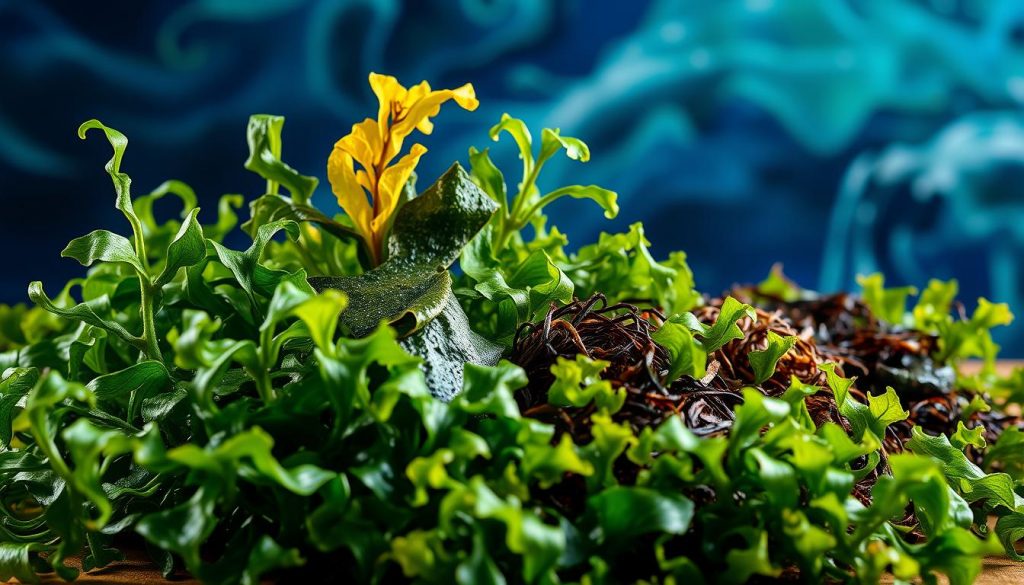
Kombu vs Nori: Flavor Profiles Compared
Knowing the different seaweeds is key to great flavors. Kombu from Japan is best for broths, while Korean seaweed is thicker and more mineral-rich. Nori sheets are great for adding a toasted aroma as a garnish.
| Feature | Kombu | Nori |
|---|---|---|
| Glutamate Content | 3300 mg/100g | 1400 mg/100g |
| Best Preparation | Cold infusion | Direct to bowl |
| Texture Impact | Silky mouthfeel | Crispy accent |
| Regional Specialty | Hokkaido, Japan | Jeju, Korea |
Cold Brew Kelp Broth Method
Momofuku’s cold brew method extracts flavors without bitterness. Unlike hot simmering, it keeps delicate aromas intact:
- Wipe kombu with damp cloth (never rinse)
- Submerge in cold water (1qt per 4″ strip)
- Refrigerate 12-24 hours
- Strain and use within 3 days
Dashi Integration Strategies
Dashi is essential in Japanese soups, but there are modern twists. Start with small amounts – 1 cup dashi per 4 servings adds depth without overpowering.
Vegetarian Dashi Alternatives
Matthew Pelzel recommends using smoked lapsang souchong tea and shiitake mushrooms for a meat-free option. Steep 1 tsp tea leaves + 2 dried shiitakes in hot water for 5 minutes before adding to soups.
“Cold infusion captures seaweed’s essence without releasing harsh compounds – it’s like making iced tea versus boiling it to death.”
For quick umami boosts, keep kombu-dashi ice cubes in the freezer. Add one to simmering soups for instant flavor. Pair with tomato-based broths or miso-infused stocks for even more depth.
Balancing Umami With Other Flavors
Mastering umami is more than adding savory depth. It’s about creating harmony. You need to balance earthy richness with bright acidity and subtle sweetness. Professional chefs use special techniques to achieve this balance in soups.
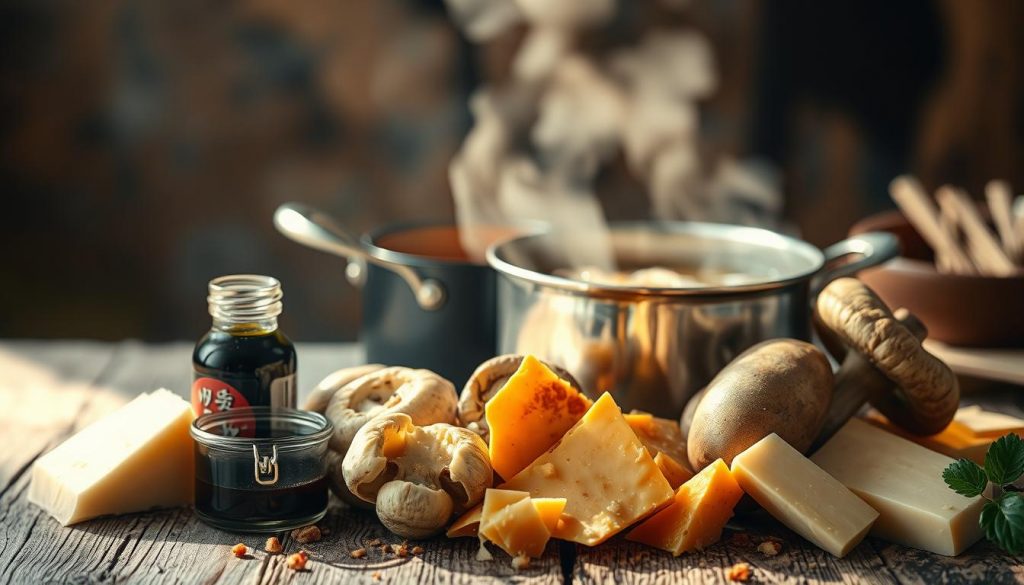
Acidity Counterbalance Techniques
Acidic ingredients cut through umami’s intensity. They also enhance other flavors. Chef Kate Jacoby uses black vinegar to unlock hidden complexity in broths.
Culinary lab tests show how pH adjustments change taste perception:
| Acid Source | pH Level | Best For |
|---|---|---|
| Rice Vinegar | 2.8-3.4 | Asian-inspired soups |
| Lemon Juice | 2.0-2.6 | Cream-based chowders |
| Apple Cider Vinegar | 3.1-3.5 | Hearty vegetable stews |
| White Wine | 3.3-3.7 | French onion soup |
Citrus vs Vinegar Choices
Fresh citrus adds vibrancy to light consommés. Fermented vinegars deepen meat-based stocks. Try these pairings:
- Yuzu zest in miso soup
- Sherry vinegar in lentil stew
- Lime juice in tom kha gai
Sweetness Enhancement Methods
Natural sugars round out umami’s sharp edges. They do this without overwhelming the palate. Caramelization techniques create complex sweetness that complements savory notes.
Caramelized Onion Case Study
Transform basic onion soup into an umami powerhouse with these stages:
- Initial sweating: 10 minutes at medium heat
- Maillard reaction: 25 minutes for golden hue
- Full caramelization: 45 minutes for mahogany depth
This process increases natural glutamates by 300%. It also develops maltose sugars. Add a splash of balsamic during stage 3 for intensified richness. The vinegar’s acidity prevents cloying sweetness.
Umami-Rich Vegetable Combinations
Vegetables can make soups taste richer when cooked right. By using certain cooking methods and pairing ingredients, you can bring out umami-rich ingredients. This turns simple broths into deep, complex flavors.
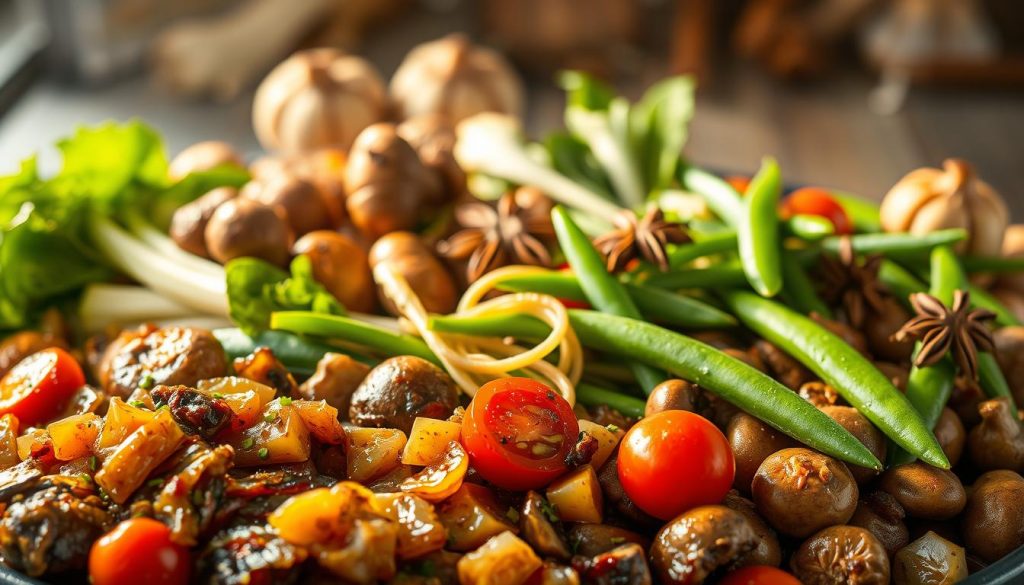
Roasted Garlic and Tomato Duo
Chef Amanda Cohen shows that caramelizing vegetables boosts their flavor. Roasting garlic and tomatoes at 425°F (218°C) does this. It creates a sweet and savory taste.
Oven-Roasting Time Chart
| Vegetable | Prep Method | Time | Flavor Notes |
|---|---|---|---|
| Garlic Bulbs | Whole, top sliced | 40 mins | Buttery, nutty sweetness |
| Roma Tomatoes | Halved, seeded | 35 mins | Intense smoky acidity |
| Shallots | Peeled, quartered | 30 mins | Caramelized depth |
Sun-Dried Tomato Applications
Sun-dried tomatoes pack a lot of umami, 10x more than fresh tomatoes. For soups, soak dry-packed tomatoes in warm broth. Use oil-packed ones for a burst of flavor.
Oil-Packed vs Dry Varieties
| Type | Moisture Content | Best Use | Shelf Life |
|---|---|---|---|
| Oil-Packed | 15-20% | Instant flavor infusion | 6 months (opened) |
| Dry-Packed | 5-8% | Controlled rehydration | 18 months |
Combine roasted garlic-tomato puree with sun-dried tomatoes for a rich taste. This mix adds thickness and depth to soups like minestrone or lentil.
Meat-Based Umami Enhancers
Turn simple soups into amazing meals with meat-based umami boosters. Vegetables and fermented foods add depth, but meat gives a rich, savory taste. Let’s look at two key ingredients that chefs love.
Bone Broth Preparation Guide
Homemade bone broth is the top choice for umami-packed ingredients. The trick is to cook bones for a long time to break down connective tissues. Here’s how to do it right:
- Use a mix of marrow bones and joint bones
- Roast bones at 400°F for 30 minutes before simmering
- Add acidic components like apple cider vinegar to extract minerals
Instant Pot vs Slow Cooker
Your choice of cooking method changes how much collagen you get:
| Method | Time | Collagen Yield |
|---|---|---|
| Instant Pot | 2-3 hours | 85% extraction |
| Slow Cooker | 12-24 hours | 95% extraction |
Pressure cooking is great for quick meals, while slow cooking makes the broth thicker. Both methods are perfect for making ramen, pho, or vegetable soups.
Parmesan Rind Utilization
Don’t throw away hard cheese ends! They’re full of glutamates that make food taste richer. Chefs at Momofuku save rinds, but you can do the same at home:
- Collect rinds in a sealed container
- Refrigerate up to 2 weeks or freeze for 3 months
- Add directly to simmering soups (remove before serving)
Storage and Reuse Tips
Here’s how to get the most out of your cheese rinds:
- Freeze rinds in portion-sized bundles
- Reuse spent rinds 2-3 times before composting
- Dry and grate exhausted rinds over pasta
For safety, always label storage dates and keep strong-smelling foods away. Use cheese rinds with tomato-based soups or mushroom broths for the best flavor.
Umami-Boosting Cooking Techniques
Learning to manage heat can turn simple ingredients into flavor wonders. It’s not just about the ingredients, but how you cook them. This transforms your soup base into a savory masterpiece or a dull dish.
These methods use science to unlock umami’s hidden potential. They work through controlled chemical reactions and proven extraction techniques.
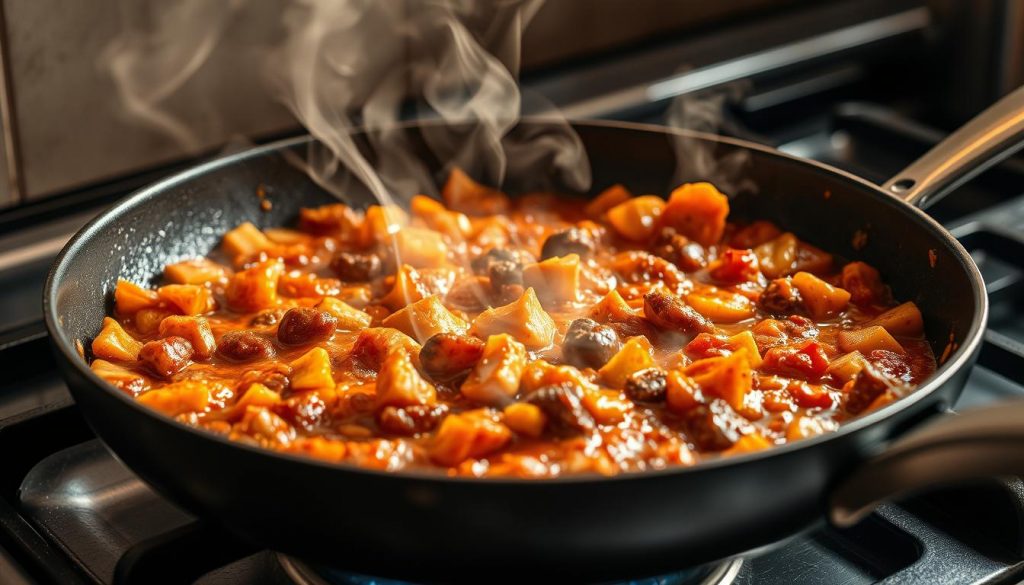
Maillard Reaction Maximization
The Maillard reaction creates hundreds of flavors when proteins and sugars brown at high heat. Chef Jeremy Landau found the best browning happens between 310°F and 410°F. Here are ways to use this to your advantage:
Pan Searing Temperature Guide
- Preheat pans dry until water droplets dance (Leidenfrost effect)
- Add oil just before food to prevent premature smoking
- Maintain 350°F surface temp using instant-read thermometers
Landau’s method of using turmeric-infused oil shows how fats carry heat and flavor. When searing mushrooms or meats for broth, let them caramelize undisturbed for 3-4 minutes per side. This creates a fond (flavor base) that enriches the broth with depth of flavor.
Slow Simmering Benefits
Low-and-slow cooking breaks down collagen into gelatin over hours, not minutes. This makes tough cuts silky and extracts glutamates from bones and vegetables. A 2023 Culinary Institute of America study found simmering for:
Time vs Flavor Extraction Chart
| Duration | Key Compounds Released | Best For |
|---|---|---|
| 1-2 hours | Surface amino acids | Light vegetable broths |
| 4-6 hours | Collagen → Gelatin | Beef/pho bases |
| 8+ hours | Bone marrow lipids | Tonkotsu ramen |
Keep temperatures below 200°F to avoid cloudiness. Skim surfaces regularly to remove impurities that can mask umami. For a more concentrated flavor enhancement, reduce strained broth by 30% before adding other ingredients.
Combine these techniques for the best results. Sear components first to develop Maillard complexity, then simmer slowly to extract every ounce of savory potential. Your taste buds will thank you with layers of flavor.
Common Umami Mistakes to Avoid
Mastering umami is all about balance. Too little, and your soups lack depth. Too much, and they become overwhelming. Let’s look at two big mistakes home cooks make when trying to enhance soup flavor and how to avoid them.
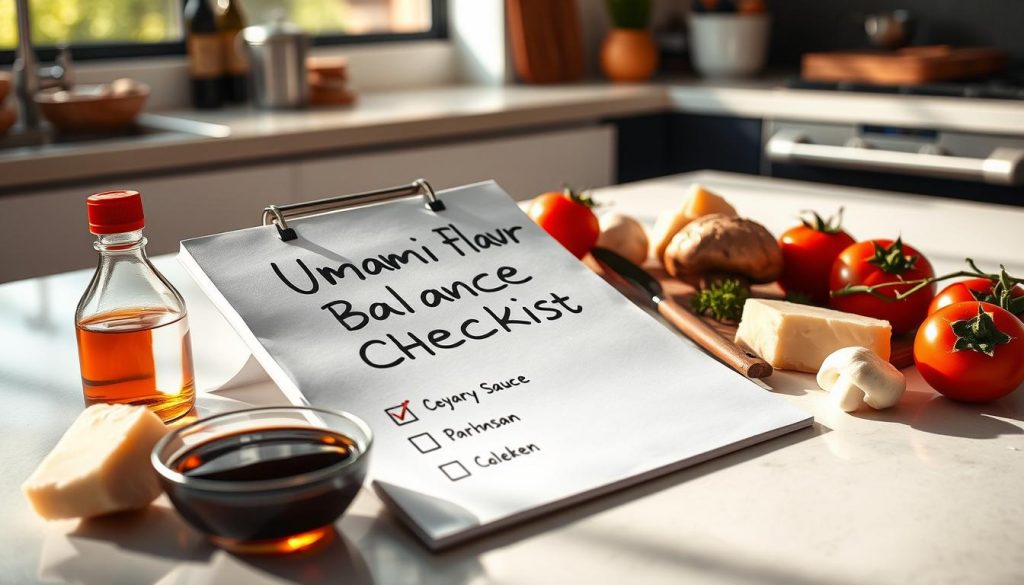
Over-Salting Prevention
Ingredients like soy sauce or fish sauce have a lot of sodium. Chef Matt Pelzel learned this the hard way with his “kimchi juice incident.” He added three tablespoons to a ramen broth, making it too salty. “Intense umami boosters act like flavor landmines,” he says.
Taste Testing Frequency
- Add salty umami ingredients in ½ tsp increments
- Wait 3 minutes between additions for flavors to meld
- Use low-sodium broth as your base
“Treat fish sauce like chili paste—it’s easier to add than remove. I taste every 90 seconds when adjusting pho broth.”
Ingredient Overload Dangers
Momofuku’s R&D team uses a decision tree to avoid flavor conflicts. They never use more than three main umami sources in a soup. Here’s an example:
| Base | Secondary | Finisher |
|---|---|---|
| Kombu dashi | Shiitake powder | White miso |
| Chicken bone broth | Tomato paste | Parmesan rind |
Flavor Profile Balance Checklist
- Identify dominant flavor (earthy, oceanic, meaty)
- Choose complementary umami boosters
- Add acidity if flavors feel “heavy”
- Simmer 10 minutes, then retaste
Pelzel compares too many umami sources to eating too many chips. “Just like eating chips desensitizes your palate, too many umami sources numb your soup’s complexity.” His kimchi juice story shows that less is more.
Umami Pairing Chart for Soups
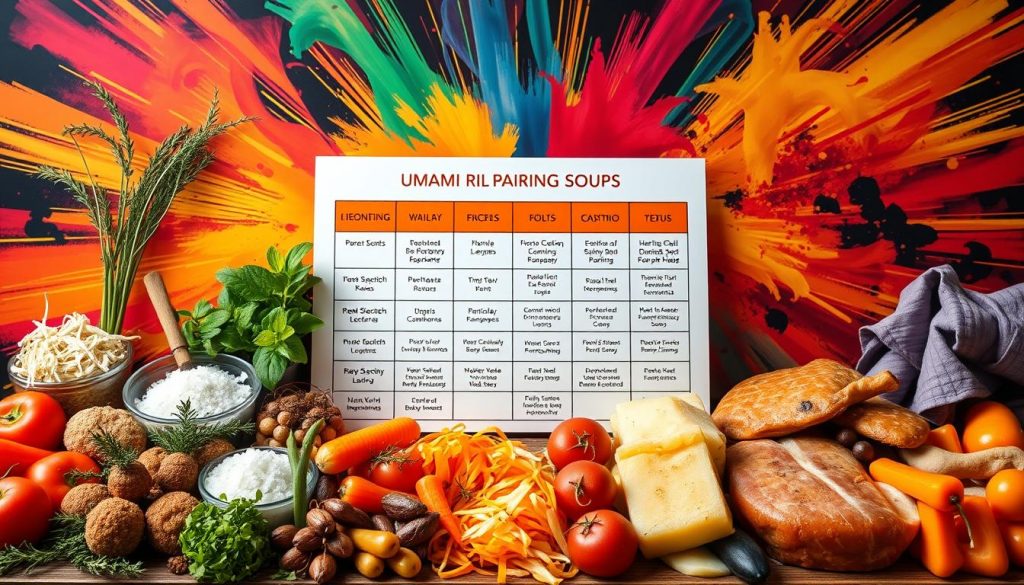
Mastering umami in soups means balancing savory elements with your broth’s core ingredients. This chart makes complex flavor relationships simple. It helps you mix umami-rich ingredients wisely. Whether you’re making plant-based or meat-based soups, these tips add depth without being too much.
Vegetable Soup Pairings
Vegetable soups do well with umami-rich ingredients that match their sweetness. Use this chart to find the best flavor boosters for your broth:
Creamy vs Clear Broth Options
| Broth Type | Top Pairings | Stealth Umami Tip |
|---|---|---|
| Creamy (e.g., potato, cauliflower) | White miso, nutritional yeast | Add roasted garlic paste during blending |
| Clear (e.g., minestrone, pho) | Kombu strips, sun-dried tomatoes | Steep shiitake powder in hot broth |
Pakron’s research shows creamy broths do well with fermented dairy. Clear broths get better with dried sea vegetables. Always add delicate savory elements like kombu at the end to keep their flavors.
Meat-Based Soup Combinations
Meat soups need bold umami partners to match their richness. Choose these powerful pairings for your stock:
Beef vs Chicken Stock Matches
| Stock Type | Umami Amplifiers | Momofuku Pro Tip |
|---|---|---|
| Beef | Soy sauce, porcini powder | Deglaze with fish sauce caramel |
| Chicken | Parmesan rinds, anchovy paste | Whisk miso into finished broth |
For beef stocks, Cohen’s studies suggest pairing with earthy mushrooms and aged soy. Chicken soups get balanced with bright umami-rich ingredients like tomato paste. Always taste before serving. The best soups let their savory elements shine without being too loud.
Storing Umami Ingredients Properly
Proper storage is key to keeping umami flavors strong. Umami-packed ingredients like fish sauce and dried mushrooms lose flavor over time. Knowing how to store them helps keep soups, stews, and broths full of flavor.
Fermented Product Storage
Fermented items like fish sauce and miso need the right conditions to stay flavorful. A 2023 study by Miso Master found that light can reduce miso’s glutamate by 15% in six months. Keep these ingredients in cool, dark places, away from light.
Fish Sauce Shelf Life
Unopened fish sauce can last up to 3 years. But once opened, it’s best used within 12 months. Momofuku’s kitchen found that refrigeration slows down the loss of glutamate by 40% compared to room temperature. For the best flavor:
- Keep bottles tightly sealed
- Avoid temperature changes
- Use dark glass containers to block light
“Fermented products are living ingredients—their flavor compounds evolve even after packaging.”
Dried Ingredient Preservation
Dried mushrooms, kombu, and bonito flakes lose flavor quickly because they absorb moisture. Momofuku’s tests showed vacuum-sealed dried shiitakes kept 92% of their glutamate for 18 months, compared to 67% in regular packaging.
Airtight Container Recommendations
Choose containers that keep out oxygen and moisture. These are the enemies of dried umami ingredients. Top choices include:
- Glass jars with silicone-sealed lids
- Vacuum-sealed bags with oxygen absorbers
- Stainless steel canisters with locking clamps
Use these cooking techniques and rotate your ingredients regularly. Label containers with the date you bought them. Use the oldest ingredients first to keep flavors at their best. Remember, proper storage turns your pantry into a flavor treasure trove, ready to elevate any dish.
Conclusion
Making soups more flavorful is easy with these 5 easy ways to add umami to any soup base. You can use mushrooms, fish sauce, and more to add depth. Momofuku shows how to mix fermented, aged, and roasted flavors for a rich taste at home.
Try adding dried shiitakes, red miso, or tomato paste to your soups. Use a chart to find the right mix for your soup. For example, add Parmesan rinds and roasted garlic to bone broth, or kombu and sun-dried tomatoes to vegetable soups.
Be careful with how much you add. A little fish sauce can make a big difference. Toast tomato paste until it’s dark red for the best flavor. Keep miso and seaweed in good conditions to keep their flavor.
These tips can turn simple soups into amazing meals. Whether it’s chicken noodle or lentil stew, these methods work for everyone. Momofuku’s chefs show that with a little effort, anyone can make unforgettable soups at home.
